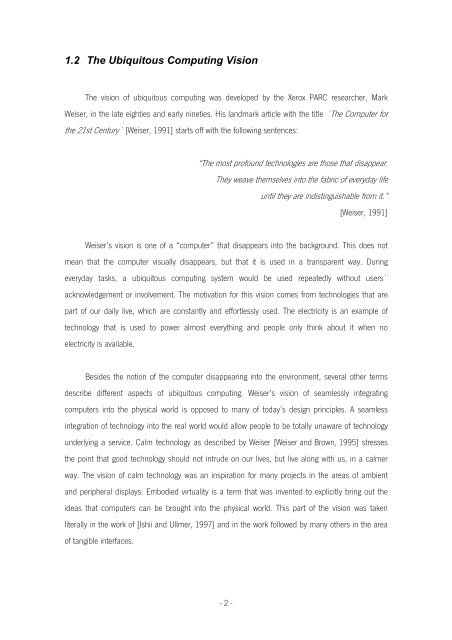Carlos Manuel Rodrigues Machado Autonomic Ubiquitous Computing
Carlos Manuel Rodrigues Machado Autonomic Ubiquitous Computing
Carlos Manuel Rodrigues Machado Autonomic Ubiquitous Computing
Erfolgreiche ePaper selbst erstellen
Machen Sie aus Ihren PDF Publikationen ein blätterbares Flipbook mit unserer einzigartigen Google optimierten e-Paper Software.
1.2 The <strong>Ubiquitous</strong> <strong>Computing</strong> Vision<br />
The vision of ubiquitous computing was developed by the Xerox PARC researcher, Mark<br />
Weiser, in the late eighties and early nineties. His landmark article with the title ´The Computer for<br />
the 21st Century` [Weiser, 1991] starts off with the following sentences:<br />
“The most profound technologies are those that disappear.<br />
They weave themselves into the fabric of everyday life<br />
until they are indistinguishable from it.”<br />
[Weiser, 1991]<br />
Weiser’s vision is one of a “computer” that disappears into the background. This does not<br />
mean that the computer visually disappears, but that it is used in a transparent way. During<br />
everyday tasks, a ubiquitous computing system would be used repeatedly without users`<br />
acknowledgement or involvement. The motivation for this vision comes from technologies that are<br />
part of our daily live, which are constantly and effortlessly used. The electricity is an example of<br />
technology that is used to power almost everything and people only think about it when no<br />
electricity is available.<br />
Besides the notion of the computer disappearing into the environment, several other terms<br />
describe different aspects of ubiquitous computing. Weiser’s vision of seamlessly integrating<br />
computers into the physical world is opposed to many of today’s design principles. A seamless<br />
integration of technology into the real world would allow people to be totally unaware of technology<br />
underlying a service. Calm technology as described by Weiser [Weiser and Brown, 1995] stresses<br />
the point that good technology should not intrude on our lives, but live along with us, in a calmer<br />
way. The vision of calm technology was an inspiration for many projects in the areas of ambient<br />
and peripheral displays. Embodied virtuality is a term that was invented to explicitly bring out the<br />
ideas that computers can be brought into the physical world. This part of the vision was taken<br />
literally in the work of [Ishii and Ullmer, 1997] and in the work followed by many others in the area<br />
of tangible interfaces.<br />
- 2 -

















